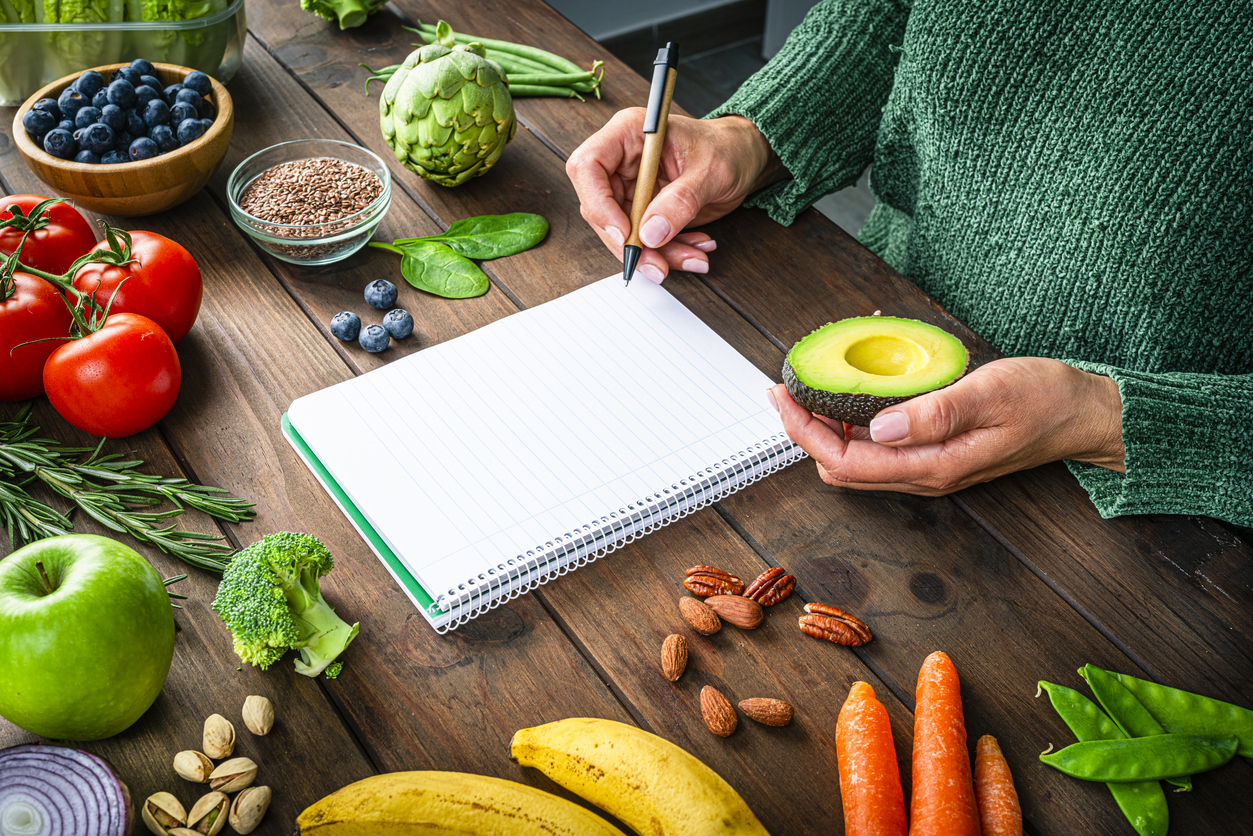
Paleo Staples: 9 Simple and Easy Recipes to Make at Home

There’s no doubt that making your own versions requires more work, but the process is rewarding and usually much cheaper than buying Paleo products off the shelf. I’m going to share nine recipes for Paleo staples that are almost always stocked in my kitchen. Affordable, kid-friendly, nourishing food is my goal.
Looking for a way to eat Paleo without needing to stock up on expensive packaged staples? Check out this article for nine recipes you can make at home. #paleo #wellness
Useful Paleo Kitchen Gadgets
In the recipes below, I will mention a number of handy kitchen gadgets. Not all are necessary, but these appliances do make Paleo cooking easier.
- Instant Pot: for bone broth and yogurt (and so much more)
- Yogurt maker: to make yogurt if you don’t want to splurge on the Instant Pot
- Immersion blender: to emulsify eggs with oil for dressings and mayonnaise
- Food processor: to grind up nuts for nut bars
- Pickle Pusher: to weigh down vegetables while they are fermenting to keep them below the liquid
- Mason jars: to store everything, from dressings to bone broth to yogurt
- Magic Bullet: for making smoothie popsicles
- Sous vide device: to “pasteurize” an egg for dressings and mayonnaise
- Digital instant-read food thermometer: to assist in making yogurt
My Top 9 Paleo Staples to Make at Home
1. Salad Dressings
At $7 or more per bottle, Paleo-friendly salad dressing costs can add up! But salad dressings are some of the easiest things to make at home, as they don’t require any cooking or special tools. A basic vinaigrette recipe usually contains:
- Avocado oil or extra virgin olive oil
- Vinegar and/or lemon juice
- Fresh or dried spices
By changing up these basic ingredients, vinaigrettes like Greek, balsamic, and Italian can be made in minutes. My go-to vinaigrette recipes are from Wellness Mama.
Creamier salad dressings, like ranch or caesar, generally require a raw egg (or a pasteurized egg that was cooked for a couple of hours at a low temperature using a sous vide device). But my favorite “dump ranch” recipe is actually egg-free! It contains:
- Olive oil
- Coconut milk
- Vinegar
- Onion powder
- Garlic powder
- Salt and pepper
- Lots of dill
Although the recipe calls for fresh dill, I use dried dill with zero complaints.
2. Mayonnaise
A 16-oz jar of Paleo-friendly mayonnaise costs $8.50 at my local grocery store! Luckily, making it at home with an immersion blender is significantly cheaper, and I can customize the flavors, like adding garlic or chipotle.
My preferred simple mayonnaise recipe is from the Whole30 website, and contains:
- Olive oil
- An egg
- Mustard powder
- Salt
- Lemon juice
The key to making an emulsion from an egg and oil is to have both at room temperature before you begin. First, blend the egg with an immersion blender, and then slowly pour in the oil while continuing to blend.
3. Yogurt
My family enjoys yogurt topped with frozen fruit, fresh fruit, or nuts pretty much on a daily basis. Luckily, we seem to have no trouble tolerating high-quality dairy products. We have saved literally hundreds of dollars making our own yogurt from milk. Using my yogurt maker, I can make 3 quarts of yogurt at a time using the following recipe:
- Heat 11 cups of whole milk in a large saucepan on medium heat until the milk reaches a temperature of 180°F to kill any bacteria. Stir often with a whisk.
- Allow the milk to cool until the temperature reaches 110°F. While the milk is cooling, stir often with a whisk to keep a film from forming on the surface. (To speed up the process, I place my saucepan in a large bowl filled partway with ice water, and stir.)
- Pour the milk evenly into 3-quart-sized mason jars. Add 3 to 4 tablespoons of store-bought yogurt or yogurt from a previous batch to each jar, and stir with a whisk.
- Place the jars into the yogurt maker uncovered, and leave the milk to ferment for 18 to 24 hours. (I have gone up to 28 hours by accident with no issues!)
- When stored in the fridge, homemade yogurt keeps for at least a couple of weeks.
Sometimes, individuals with lactose intolerance and FODMAP-intolerance can tolerate homemade yogurt. Yogurt that has been fermenting for 24 hours is close to being lactose-free if your starter yogurt has lactose-consuming bacteria species.
4. Nut Bars
Paleo nut bars are a great alternative to granola bars, which usually contain grains, excess sugar, and/or vegetable oils. They are one of our go-to travel snacks—but fair warning that they don’t keep their shape if left at room temperature for too long. My kids also love to crumble the bars on top of yogurt, kind of like grain-free granola.
Paleo Nut Bar Recipe
Ingredients:
- 6 cups nuts or seeds (I use 2 cups each of dry roasted almonds, cashews, and walnuts)
- 2 cups raisins
- 2 cups unsweetened coconut flakes
- ½ cup coconut oil (or butter, ghee)
- 1 ¼ cups nut butter
- ⅓ cup raw honey
- 1 tsp vanilla extract
- ½ tsp sea salt
- 2 tsp ground cinnamon
Directions:
- Grind the nuts/seeds in a large food processor for about 10 seconds, to create a variety of sizes, from sand-size to small chunks.
- Pour ground nuts into a large bowl, add in raisins and coconut flakes, and stir to combine.
- In a small saucepan, melt coconut oil, peanut butter, honey, vanilla, sea salt, and cinnamon on medium heat until it bubbles, stirring often.
- Pour the hot mixture over the dry mixture and stir until everything is coated evenly.
- Pour the mix into a 9×13-in. pan. Press down firmly and evenly.
- Place in the fridge for at least six hours before cutting into pieces.
5. Bone Broth
The benefits of bone broth span many aspects of health. Rich in collagen, glycine, other amino acids, and minerals, bone broth consumption boasts health benefits for skin, bones, and joints, the gut and digestion, and more. The Weston A. Price Foundation provides simple bone broth recipes for chicken, beef, and even fish stock.
A basic bone broth recipe includes lots of cartilage-rich bone pieces, water, a splash of vinegar, carrots, celery, onions, and spices like sage, thyme, rosemary, and parsley. With a slow cooker, bone broth should simmer for 24 to 48 hours. With an Instant Pot, bone broth can be ready in just a few hours!
6. Smoothie Popsicles
Smoothies-turned-popsicles are one of my favorite parenting “hacks,” but they aren’t just for kids. On hot summer days, popsicles hit the spot, but the popsicles available at the grocery store leave much to be desired.
My favorite popsicle recipe uses a few simple ingredients:
- ½ banana
- ½ cup yogurt
- ½ cup frozen mango
- 1 tbsp almond butter (optional)
Using the Magic Bullet, blend all the ingredients and then pour them into popsicle molds. Place them in the freezer for several hours. When made in the morning at breakfast, the popsicles are ready to eat that same day after school (or work!).
7. Probiotic Switchel
Have you ever bought the probiotic drink kombucha? It’s crazy expensive! A cheap, easy alternative to kombucha is switchel—it’s not produced in the same way as kombucha, but it’s a deliciously refreshing probiotic drink that can be easily made at home and fermented overnight.
My preferred recipe comes again from Wellness Mama, and includes the following ingredients:
- Raw apple cider vinegar (the probiotic component)
- Raw honey
- Lime juice
- Ginger
- Filtered water
In a pinch, I have used ground ginger instead of fresh, and packaged lemon juice in place of fresh lime juice. My favorite way to enjoy switchel is by mixing it in a one-to-one ratio with lemon or lime seltzer water.
8. Sauerkraut
Bring on the probiotics! Fermented fruits and vegetables were staples of our ancestors’ diets. They preserved well and provided ample probiotics to keep our guts healthy. I have dabbled in fermented vegetables, but the tried-and-true recipe I use is from Nourishing Traditions for sauerkraut.
Homemade sauerkraut is straightforward. First, the cabbage needs to be sliced into very thin, small pieces. After sprinkling sea salt (note: do not use iodized salt!) onto the shredded cabbage, pound the cabbage with a mallet or use your hands to knead the cabbage for 10 or more minutes until the juices are released from the plant cell walls.
Once the juices are able to cover the sauerkraut if packed down, transfer the cabbage to mason jars. Cover the cabbage with its own juices and some spices, and leave it to ferment for a few days. I prefer to use the Pickle Pusher, but it’s not necessary as long as you make sure to push the cabbage below the liquid a couple of times each day to prevent mold formation. If mold does form, you can usually get away with just scraping off the top layer and proceeding with fermentation.
Sauerkraut is an excellent side dish to many recipes, from Mexican-inspired cuisine to standard “meat-and-potato” fare.
9. Spice Blends
This last Paleo staple serves more as a money-saving hack. When people first make the change to eat “Paleo,” they still want flavor. All too often, this leads to buying spice blends for all kinds of cuisine. These spice mixes cost a fortune compared to the price it actually costs to mix them up yourself. If you are cooking most of your meals at home, you probably already have many of the spices that are included in common spice blends you find at the grocery store.
My solution is to premake commonly used spice blends in different dishes. For some examples, I always keep Cajun, Mexican, Italian, Greek, and Ethiopian spice mixes in bulk in 8-oz mason jars in my pantry. If you search around, there is a plethora of recipes on the internet, including here.
Do you have any of these Paleo staples in your kitchen? What would you add to this list?
Our hunter–gatherer ancestors lived very different lives than we do. They ate nutrient-dense foods (not processed, inflammatory ones), they were active (not sedentary), and they made time for pleasure and rest (instead of living in a constant state of stress and busyness). This mismatch between the way we evolved and the way we now live is driving the current chronic disease epidemic. For many, correcting the mismatch with an ancestral diet and lifestyle is a great place to start.The ADAPT Health Coach Training Program includes course materials on ancestral diet and lifestyle, Functional Health, and the art and practice of coaching. Graduates of this program are well equipped to collaborate with Functional Medicine practitioners and support clients as they make lifestyle changes and better their health.
Are you interested in a career as a Functional health coach? Find out if the ADAPT Health Coach Training Program is the right step forward for your future.






